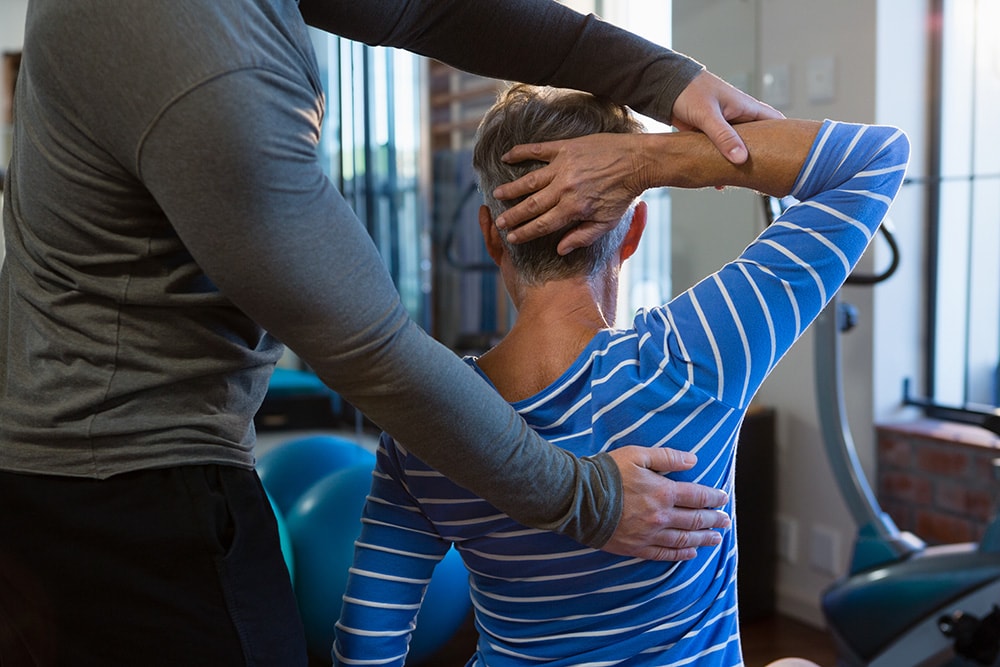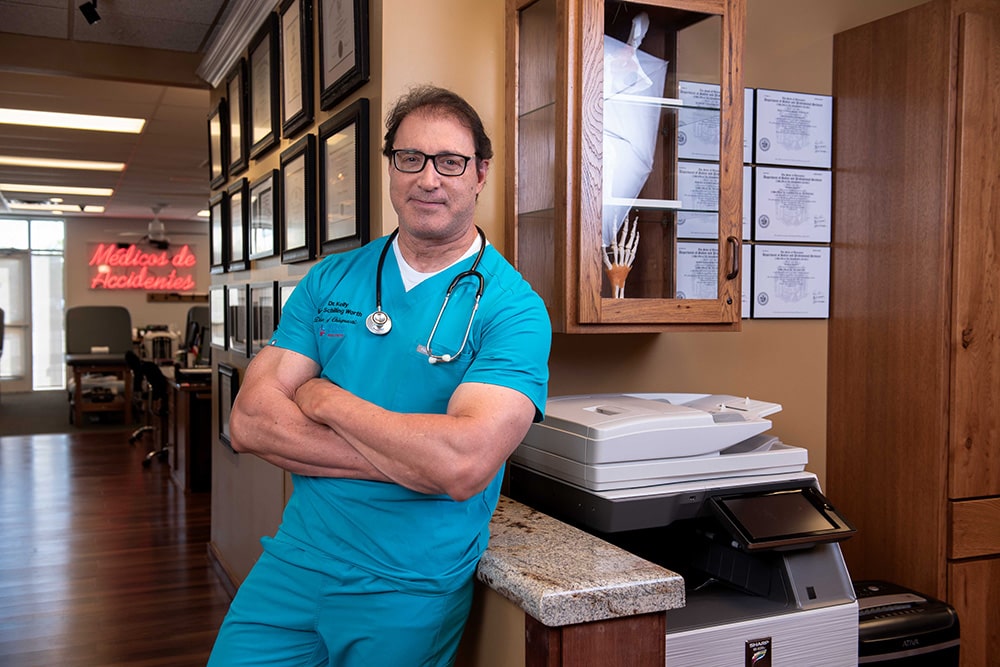Shoulders have a greater range of motion than any other joint in the body. When someone suffers trauma to the shoulder or is dealing with shoulder pain, it could significantly limit their day-to-day routine. When an employee experiences shoulder pain or trauma at work, it must be addressed as soon as possible for their health and safety. Employers have workers’ compensation insurance to help cover medical expenses and lost wages when an employee is injured. Unfortunately, obtaining these benefits can be challenging for a victim to accomplish alone as they grapple with their injury, and having a doctor well-versed in the workers’ compensation system in their corner would be in their best interest.
At Spine and Joint Institute of Milwaukee, we provide comprehensive care to injured workers while ensuring their medical treatment is fully documented for their workers’ compensation claims. We believe that workers’ compensation documentation doesn’t have to be a hassle for a shoulder injury patient. Our patients can rest assured that we help them heal while building their most robust workers’ compensation case for a speedy recovery and safe return to work.

Frozen shoulder, also known as adhesive capsulitis, is a condition characterized by stiffness, pain, and limited range of motion in the shoulder joint, typically resulting from inflammation and thickening of the shoulder capsule.
The symptoms of a rotator cuff injury can vary depending on the severity of the tear and other individual factors. Common symptoms of a rotator cuff tear include:
It's important to note that not everyone with a rotator cuff tear or rotator cuff injury experiences all these symptoms, and some individuals may have a tear without initially realizing it, especially if the tear is small or they have a high pain tolerance. If you suspect you have a rotator cuff tear or injury or are experiencing persistent shoulder pain or weakness, consult with a medical professional specializing in rotator cuff injury care.
Treatment for a rotator cuff tear depends on several factors, including the severity of the tear, the individual's age, activity level, and overall health. Standard treatment options include:
Conservative Treatment. For minor rotator cuff tears or in cases where surgery is not recommended, conservative approaches may be sufficient. These include rest, activity modification, physical therapy to strengthen the surrounding muscles and improve range of motion, and anti-inflammatory medications to manage pain and swelling from the injury.
Corticosteroid Injections. Injections of corticosteroids into the shoulder joint can help reduce rotator cuff inflammation and sometimes alleviate pain. These are typically used in conjunction with other conservative treatments.
Platelet-Rich Plasma (PRP) Therapy. PRP therapy involves injecting a concentration of platelets from the patient's own blood into the affected area to promote healing from the rotator cuff injury.
Surgery. If conservative treatments fail to provide relief for the injury or if the rotator cuff tear is severe, surgery may be necessary. Surgical options include:
Rehabilitation. Rehabilitation is a crucial aspect of conservative or surgical treatment of a rotator cuff injury. A structured physical therapy program can help strengthen the muscles around the shoulder joint, improve range of motion, and facilitate recovery from the injury following surgery.
The choice of rotator cuff injury treatment depends on various factors with each patient, and it's essential to consult with a healthcare professional to determine the most appropriate approach for your specific situation.

Common signs and symptoms of a work-related shoulder injury can vary depending on the specific injury, but they often include:
Treatment plans are often individualized based on the patient's specific injury, health, goals, and lifestyle factors and may involve a combination of these approaches to achieve optimal outcomes. It's essential to consult with a healthcare professional for a comprehensive evaluation and personalized treatment recommendations for shoulder injuries. Treatment for shoulder injuries depends on the specific type and severity of the injury but may include:
Common causes of shoulder injuries in the workplace include:
Performing repetitive tasks or motions involving the shoulder joint, such as lifting, reaching, pushing, or pulling, can lead to overuse injuries like tendonitis, bursitis, or rotator cuff tears.
Exceeding the physical limits of the shoulder muscles and tendons due to heavy lifting, carrying, or pushing/pulling objects, especially when proper lifting techniques are not followed.
Working in environments with inadequate ergonomic design, such as improper workstation setup, poorly designed tools or equipment, or awkward postures, can contribute to shoulder strain and discomfort over time.
Engaging in physically demanding jobs or manual labor tasks that require frequent use of the arms and shoulders, such as construction, manufacturing, warehouse work, or agriculture, increases the risk of shoulder injuries.
Accidents involving slips, trips, or falls in the workplace can result in shoulder trauma, such as dislocations, fractures, or soft tissue injuries, particularly if the individual instinctively reaches out to break their fall.
Direct impact or trauma to the shoulder region from falling objects, collisions, or accidents with machinery or equipment can cause fractures, contusions, or other acute injuries.
Lifting heavy objects incorrectly, such as using the back instead of the legs, twisting while lifting, or lifting objects that are too heavy for one person, can strain the muscles and ligaments of the shoulder, leading to injury.
Prolonged exposure to vibrations from handheld tools or machinery, such as jackhammers or power tools, can contribute to muscle fatigue and strain in the shoulders and upper body.
Jobs involving repetitive arm movements, such as assembly line work, painting, or typing, can cause overuse injuries and strain the shoulder muscles and tendons over time.
Poorly designed workstations or equipment that require awkward reaching, stretching, or overhead movements can increase the risk of shoulder injuries and musculoskeletal disorders.
Working in cold environments without proper insulation or protective clothing can lead to decreased muscle blood flow and increased stiffness and susceptibility to injury in the shoulder region.
When you suffer a shoulder injury at work, it could put your life on pause. You may be unable to return to work and support yourself and your household as you try to cope with the injury and pain. Our work injury doctors at Spine and Joint Institute of Milwaukee know how much the proper shoulder injury treatment and documentation can make a difference for an injured worker, so we comprehensively document your injuries and treatment for your workers’ compensation case. We are medical professionals well-versed in the workers’ compensation claims process, care about your health and well-being, and are ready to help get you on the road to recovery.
If you or a loved one has experienced a shoulder injury on the job, contact Spine and Joint Institute of Milwaukee right away. Our team is here to provide the support and care you need to navigate the challenges of shoulder injury recovery while documenting your treatment properly for your workers’ compensation claim. We work closely with our injury patients and help ensure a swift recovery, a stress-free workers' compensation claims process, and a safe return to work.

If you are not receiving proper care for your injury, you have the right under Wisconsin Workers' Compensation Law to choose your own doctor and to get a second opinion.